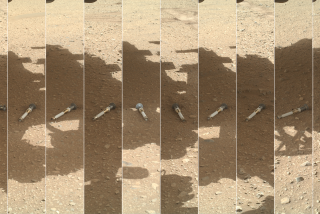NASA’s Mars 2020 rover gets tools to search for signs of past life
- Share via
It’s official: The Mars 2020 rover’s instruments have been chosen, and they include a super-laser and stereo vision!
This successor to NASA’s Mars rover Curiosity may have the same skeleton as its predecessor, but its suite of scientific tools will take its exploration to the next step: looking for bio-signatures – actual signs of past life.
The Mars 2020 rover builds on the successes of Curiosity, known formally as the Mars Science Laboratory, which landed in Gale Crater in 2012. The high-tech robotic geologist chewed up and digested it in a chemical analyzer, discovering that the Red Planet once hosted habitats that were friendly to living things.
The new rover would build on those discoveries, looking to see whether there are any direct signs of life. It would also gather and cache valuable samples for another future spacecraft to pick up.
“How do we find bio-signatures? That’s not so easy. It’s difficult here on this planet,” Michael Meyer, lead scientist for NASA’s Mars Exploration Program, said in reference to Earth. “And we know a lot more about it than we do Mars.”
Meyer gave the example of ancient, early fossils on Earth known as stromatolites, which can often be mistaken for layers of sedimentary rock. So the scientists are bringing a set of tools that will help them to tease apart the differences between plain old geology and actual traces of life.
The instrument suite will include a souped-up Mast Camera called Mastcam-Z, which will have a powerful ability to zoom as well as stereo vision. This camera will help the team create detailed maps of the terrain, allowing the rover to safely travel for longer stretches at a time. It will also allow the team to create movies out of the still images that Mars 2020 sends back.
“You’re going to feel like you’re on Mars,” said John Grunsfeld, head of NASA’s Science Mission Directorate. “It’s going to be fantastic.”
They’ll also have a fancier version of Curiosity’s ChemCam called Supercam, with an even more sophisticated laser-shooter that will allow them to examine rocks in both visible and near-infrared wavelengths of light.
The rover will also host instruments that will provide valuable insight for future human visits to the Red Planet. Mars 2020 will carry an experiment to produce oxygen out of the carbon dioxide in the planet’s thin atmosphere, which could one day be useful for generating fuel. Mars 2020 will also hold a set of environmental sensors that will measure factors like temperature, dust and wind speed and direction.
The rover will also wield a separate instrument on its arm with an ultraviolet laser to help look for organic compounds and minerals that formed in salty water. It will even have a radar imager that can probe beneath the surface to create a centimeter scale map of its geologic structure.
NASA said it received double the usual number of proposals to create instruments for the rover – a testament to the high interest in Martian exploration, they said.
Developing the instrument package is estimated to cost $130 million; the overall price tag could be close to a billion or so dollars cheaper than Curiosity’s $2.5-billion price tag. That’s in part because it will use the same body plan – and even spare parts – from the Mars Science Laboratory rover, which landed on the surface nearly two years ago.
The rover also will not boast the internal laboratory carried by Curiosity, which could take rock ground up by its drill, eat it and analyze it chemically. The science payload will ultimately be about 45 kg instead of 70 kg.
But the rover will also be able to sample rocks without powdering them, pulling out whole cylindrical cores that could be studied in-depth if they were ever brought back to Earth.
Even if the samples that Mars 2020 would cache are never picked up, the system will still give the team valuable practice at safely and effectively storing precious samples.
While the instrument suite and the mission’s goals carry a certain amount of risk, it’s worth a try, Grunsfeld said.
“Unless we try hard things we’re not going to get the really great science,” he said.
Love Mars? Follow @aminawrite for more dispatches from the Red Planet.







